Schrade SCHF51 and SCHF51M Knives Reviewed

Marketing from Schrade
Schrade Frontier Full Tang Fixed Blade Knife, Powder Coated 1095 High Carbon Steel Drop Point Blade with Finger Choil, one with a Ring Textured TPE Handle and the other with a Picked Micarta Handle, both with Spine and Grip Jimping, Lanyard Hole, Black Polyester Belt Sheath with Ferro Rod and Sharpening Stone.
Manufacturer: Schrade, www.schrade.com
Model: SCHF51, SCHF51M
Overall Length: 10.85 inch (27.56 cm)
Blade Steel: 1095 High Carbon Steel
Blade Length: 5.05 inch (12.83 cm)
Blade Thickness: 0.22″ (5.6 mm)
Handle Material: Ring Textured TPE, Picked Micarta
Handle Length: 5.97 inch (15.16 cm)
Weight: 13.9 oz, 15.04 oz
Accessories: Black Polyester Belt Sheath with Ferro Rod and Sharpening Stone
Warranty: Limited Lifetime Warranty against any manufacturing defects
Origin: Made in Taiwan
UPC: 044356225182, 044356225748
MSRP: $53.33, $70.40
The Review
New for 2016, Schrade has just released their much anticipated SCHF51 and SCHF51M Frontier fixed-blade knives with a design profile based on their highly regarded SCHF36 that won Blade Magazine’s People’s Choice of the Year in 2015. Today I’ll be putting both of these new blades through a series of basic bushcraft tests, so let’s get on with it and see how well they fare…


Initial Thoughts
As a big fan of Schrade’s SCHF36 and SCHF37, I was very interested to see where they were going to take the design of the new blades that would be closely based on them. Like many, I too had an issue with the thick asphalt-like protective coating on the blade and the aggressive jimping on the top and bottom of the handle. Even though Schrade just released the SCHF51 and SCHF52, this article will focus solely on the SCHF51, I feel the SCHF52 is deserving enough of its own review.
A couple of months ago I received the package from Schrade and pulled the new blades out, I was pretty excited to see that they had listened to much of the feedback that they had received. This is one of my favorite things about Schrade. They always listen to their customers and provide great customer service.
The SCHF51 and SCHF51M are made from the same Taiwanese 1095 high carbon steel with the exact same 5.05-inch drop-point blade profile, finger choil and hollow grind as the SCHF36. Only the protective coating has been changed on the blade. This time Schrade opted for a thinly applied PTFE powder coating with a smooth finish instead of the thick powder coating with a rough finish that would tend to cause drag and gum up with material as the blade was being used. This allows the Schrade logo and model number to pop better on these new knives.
Another notable change for Schrade has to do with the blade material on the micarta model. The SCHF36M was made from 8Cr13MoV stainless steel whereas the SCHF51M is made from the same 1095 steel as the SCHF51, but with the picked linen micarta scales instead of the ring-textured TPE.
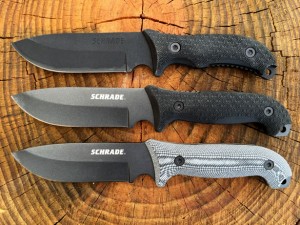 The handle length, profile and jimping are where the biggest changes have occurred between the two models. The handle of the SCHF51 and SCHF51M are 5.97 inches in length as opposed to 5.36 inches of the SCHF36 and SCHF36M. Additionally, the rear-quillion is much more pronounced providing a better grip and improved retention while chopping and slashing. As a result, this does shift the point of balance back behind the fingerguard making it little handle-heavy. However, the point of balance is perfect when choking all the way up to the finger choil.
The handle length, profile and jimping are where the biggest changes have occurred between the two models. The handle of the SCHF51 and SCHF51M are 5.97 inches in length as opposed to 5.36 inches of the SCHF36 and SCHF36M. Additionally, the rear-quillion is much more pronounced providing a better grip and improved retention while chopping and slashing. As a result, this does shift the point of balance back behind the fingerguard making it little handle-heavy. However, the point of balance is perfect when choking all the way up to the finger choil.
The lower handle finger groove and jimping have also been removed for a much more comfortable grip, and the upper handle jimping on the thumb ramp is much less aggressive. These tweaks to the handle area positively address many of the hotspot complaints from the SCHF36.
While all of these changes may seem minor, combined they make a huge difference to the fit and finish of the SCHF51 and SCHF51M. Many early reviewers are calling the SCHF51 and SCHF52 nearly perfect.
Like many Schrade knives, the SCHF51 and SCHF51M each come with a black polyester belt sheath with a ferro rod, striker, and sharpening stone neatly tucked in the attached pocket.
Features
Now lets focus on the features of the SCHF51 and SCHF51M in more detail…
The Blade
Schrade’s SCHF51 is a medium-sized survival blade with an overall length of 10.85″, a blade length of 5.05″ and a weight of 13.9 ounces. It is made from a rugged slab of 1095 high carbon steel nearly 1/4″ thick from tip to pommel and 1.5″ at its widest. This broad full-tang design provides all of the strength and rigidity that you would expect from a good survival knife.
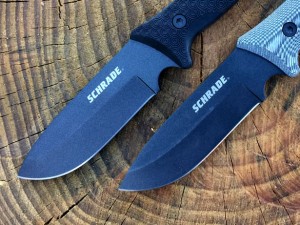 1095 high carbon steel is a very popular steel alloy that is much harder than most other lower-carbon steel alloys so it tends to hold an edge much longer making it an excellent choice for bushcraft and survival type blades. Not to mention, it is typically easier to sharpen steel blades than stainless blades.
1095 high carbon steel is a very popular steel alloy that is much harder than most other lower-carbon steel alloys so it tends to hold an edge much longer making it an excellent choice for bushcraft and survival type blades. Not to mention, it is typically easier to sharpen steel blades than stainless blades.
While the 1095 steel blades can really take a licking and still hold an edge, the high carbon content make it very susceptible to rust and corrosion without proper care and maintenance. Even protective coatings can’t prevent the corrosion from occurring. But by keeping the blade dry and lightly oiled when not in use, it just might last you a lifetime.
The SCHF51 has a solid blade, thick and heavy-duty, yet well-balanced making it ideal for chopping, prying and digging without any worry of damaging the tip or the blade. It has a stout 90° spine with an attractive drop-point pattern and a solid tip. The blade is ground with a deep hollow-grind and a slight compound bevel without any serrations. This is a very common grind on factory knives today. The shape of this blade provides a bit more leverage perfect for heavy bushwhacking tasks like chopping and lighter bushcraft techniques like carving and shaving sticks.
The Handle
The SCHF51’s handle scales are made from a hard, durable TPE rubber with an aggressive ring pattern providing an excellent non-slip grip even in wet conditions. Thermoplastic elastomers (TPE), sometimes referred to as thermoplastic rubber is made from a mix of plastic and rubber polymers providing both thermoplastic and elastomeric properties. The handle design consists of a moderate palm-swell making it easy to grip with or without gloves.
The SCHF51M’s handle scales are made from an extremely durable picked linen micarta with a coarse pattern providing an excellent non-slip grip even in wet conditions, making it a great choice for a knife handle. However, the scale pattern is coarse enough that some may find it more comfortable to wield with gloves. Micarta is a resin impregnated fibre compound produced with a wide variety of resins and fibers cured under high pressure and high temperature.
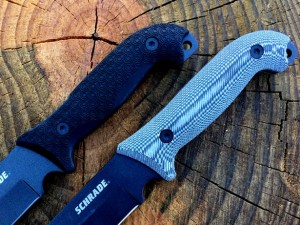 Whichever the model, the two handle scales are attached through the full-tang blade with two recessed allen bolts threaded directly into the knife steel allowing it to absorb much of the shock when chopping or batoning, thereby reducing fatigue.
Whichever the model, the two handle scales are attached through the full-tang blade with two recessed allen bolts threaded directly into the knife steel allowing it to absorb much of the shock when chopping or batoning, thereby reducing fatigue.
On the upper-side of the handle near the thumb ramp, there are seven jimped notches providing a variety of gripping options.
There is a large finger choil in front of the fingerguard providing exceptional control over the blade for fine bushcraft tasks like making trap triggers and feathering sticks. The pommel located at end of the handle has a lanyard through hole at its base sized perfectly for a paracord tether. The pommel is smooth-faced and can be used for light hammering in a pinch.
The Sheath
The SCHF51 and SCHF51M each come with a belt sheath made from a heavy-duty black polyester. The blades fit snuggly in a plastic-lined pocket and is held firmly in place with a retention strap and button closure. The pocket lining is not reversible so the sheath is configured for right-hand carry only.
Sewn onto the front side of the sheath there is a small pouch containing a ferro rod and sharpening stone with an elastic band and velcro flap to hold them firmly in place. There are two riveted eyelets attach the lower-end of the sheath with a short nylon rope to use as a leg strap, but a length of paracord would certainly be a good improvement. The ferro rod is a good quality and works very well with the 90° spine providing ample sparks to get a fire going.
The belt loop is capable of handling a 2.25″ belt and can be rapidly put on or taken off with a simple velcro closure.

Functional Testing
Now lets see what the SCHF51 and SCHF51M can do… In order to provide a some sort of apples-to-apples comparison between blades, I will be performing five durability tests; Chopping, Batoning, Fine Blade Control, Tip Strength and Edge Retention. In a survival situation, all resources are fair game. However, since I am not in a life-or-death situation, I’ll stick to some dead wood that I have lying around for these tests.
Chopping
To kick off the testing, I decided to prepare a few logs for splitting with a baton in the next test. To do so, I obviously needed to cut them down to size otherwise known as bucking. I started off with a long branch about 3-4″ in diameter, perfect for testing out a 5″ blade. At a few ounces shy of a pound, the SCHF51’s weight provides quite a lot of force when striking it against something. By choking back on the handle, effectively gripping it with two or three fingers will greatly increase the radius of your swing, providing a lot more centrifugal force behind the blade while chopping.
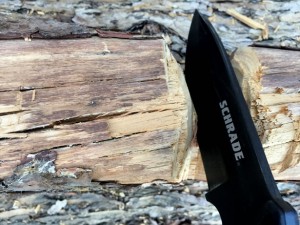 When chopping, or bucking a log you simply strike the log at a 45° angle from two perpendicular directions along the cut-line, effectively making a “V” in the material used, otherwise known as the kerf. The kerf should equal the diameter of the trunk, and when cutting from both sides, the kerf would essentially be half the diameter.
When chopping, or bucking a log you simply strike the log at a 45° angle from two perpendicular directions along the cut-line, effectively making a “V” in the material used, otherwise known as the kerf. The kerf should equal the diameter of the trunk, and when cutting from both sides, the kerf would essentially be half the diameter.
The hollow-grind of the SCHF51 bit deeply into the material and the chips went flying with each strike against the log. After a dozen or so swings I was already more than half-way through the first section. I kept chopping away at the branch until I had bucked three logs about 16″ in length. Furthermore, the SCHF51 made quick work of all of the smaller branches that I cut up as well.
I think the only thing that would have made this blade perform any better at chopping would have been a recurved edge. For choppers, I always prefer recurves because a bellied edge tends to bite deeper than a flat edge due to the surface distribution. Even axes and hatchets have curved edges for this reason. But I was very impressed by the performance of the SCHF51 nonetheless.
Additionally, the TPE handles on the SCHF51 seemed to absorb much of the shock and vibration from each strike, whereas the micarta handles on the SCHF51M did not absorb near as much. But with some gloves, you don’t really notice the difference between the two knives with the exception of the extra ounce of the SCHF51M.
Batoning
To test the SCHF51 at splitting logs with a baton, I first found a 3″ baton about 2′ long. My goal was to split a few logs into small kindling that I had previously bucked down to size in the last test.
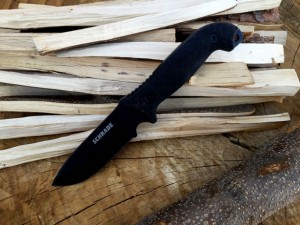 With each of the logs spanning 3-4″ in diameter, the SCHF51 was easily long enough to half them. If they had been any larger, they would have required using an alternative method to split them.
With each of the logs spanning 3-4″ in diameter, the SCHF51 was easily long enough to half them. If they had been any larger, they would have required using an alternative method to split them.
I placed the first log on its end and began to whack spine on both sides of the SCHF51 evenly with the baton. It split log with ease. First in half, then quarters, and so on until I had a decent pile of small kindling. The protective coating did not cause much resistance if any, and the hollow-grind actually contributed to the splitting of the material. As a result, very little effort was necessary to drive the blade through the log from end-to-end, and it became easier and easier as the material got smaller.
I repeated the test two more times, splitting the rest of logs into small kindling as well. I also used the baton and blade to cut a few 2″ branches into smaller pieces. The SCHF51 and baton made the job much easier than I thought it would be. The thick spine only caused a minimal amount of damage to the baton, even with all the use, unlike some narrower blades and blades with swedges. I have to say, I was thoroughly impressed results.
Fine Blade Control
To test the SCHF51 at fine blade control, I had three bushcraft tasks in mind. The first task was a very common test for reviewers, feathering a stick, the second was to make a handful of tent stakes with notches and pointed ends, and the third to make a basic figure-four trap trigger.
To perform the first part of this test, I used one of the pine sticks from the three logs that I had just split. After knocking off the sharp corners with the knife, I began trying to shave long thin curls off the stick. I did not have any problem shaving fine curls, just not the long thin shavings that you always shoot for. These looked more like the shavings found underneath a heavily used drill press, but they light up with a ferro rod just the same.
 Making tent stakes is really pretty easy. First, I picked up a few 1/2″ sticks and cut them all down to about 10″ in length. Then I cut in all of the notches 1″ down from the end to prevent them from splitting. I found that the thick spine really helps with the comfort when you are using your thumbs for extra leverage as you advance the blade through the material.
Making tent stakes is really pretty easy. First, I picked up a few 1/2″ sticks and cut them all down to about 10″ in length. Then I cut in all of the notches 1″ down from the end to prevent them from splitting. I found that the thick spine really helps with the comfort when you are using your thumbs for extra leverage as you advance the blade through the material.
It only took a couple minutes or so on each notch and they were all done. The last step was to cut a point on the other end of each of the stakes. I tried a few different methods including holding the blade fixed against my chest and drawing the stick across it without issue.
The final task was to make a figure-four trap trigger for a standard deadfall trap. This requires three sticks, the upright stick, the release stick, and the bait stick. The upright stick has a pointed end and a squared-out notch cut out near the other end. The release stick has a pointed end and a v-shaped notch near the other end. The bait stick has a point at one end, a v-shaped notch at the other, and a squared-out notch near the center.
The tolerances must be pretty tight to make this trigger work properly so I took my time, but after about 20 minutes I had all of my notches fit and working. The thick broad blade definitely added to the difficulty on this task. A smaller thin blade would have been much easier to work with on this one.
Tip Strength
To test the SCHF51’s ability to stab and pierce without damaging the tip or breaking the blade, I drove the blade into the side of a stump about 16″ in diameter as deep as I could. Then I proceeded to loosen it using a side-to-side motion until it was loose enough to pry out. I repeated this test a few more times just for good measure as I shredded the log. I even tried standing on the broad-side of the blade after driving it deep into the side of the log without any bending or breaking.
Next, I used the tip of the SCHF51 to bore a hole into the side of a log to further test the strength of the tip. I performed this test by twisting the blade back and forth until a hole was bored approximately 1″ in diameter and about 3/4″ deep into the log.
The SCHF51 performed both of these tasks without any issues whatsoever. It is an extremely rugged blade with a stout tip, seemingly indestructible.
Edge Retention
After all of the other functional testing had been completed, the final test for the SCHF51 was to slice through a single-sheet of printer paper to demonstrate its ability to hold an edge. The blade easily survived all of the other tests without any sign of cracks, chips or other imperfections of any kind with the exception of some slight wear on the blade’s protective coating. Even with all of the punishment that was thrown at it, the SCHF51 cleanly sliced through the sheet of paper proving that it can hold an edge.
Final Thoughts
Schrade’s SCHF51 and SCHF51M are rock-solid survival knives made from rugged 1095 high carbon steel so they are easily capable of performing rigorous bushcraft and survival tasks in some of the most extreme conditions. They are very well-balanced and quite comfortable to wield providing exceptional control over the blade while minimizing fatigue from heavy use.
My biggest gripe aside from not having a recurve has to do with the jimping. Many enthusiasts don’t like jimping at all, so I know it is really just a preference thing. I think that the jimping would be better served on the foreside of the thumb ramp to provide better traction when you choked up on the blade.
It’s extreme durability, medium-size, light weight, and built to last make either of them an ideal choice for most emergency preparedness and survival solutions. Quite a lot of bang for your buck with these blades. At only $40, it would be nice to have a few of these stashed around the house and packed in my survival bags. Two thumbs up!
Right now you can find both of these blades online at Knife Depot, but soon enough they will be readily available on Amazon and other Internet sites for right around $40. Just as soon as they are, I’ll be sure to add the links to this article and LTS Webstore.
You can find this and other Schrade products here: http://amzn.to/2c0kjZF
![]()
About Taylor Brands and Schrade Cutlery
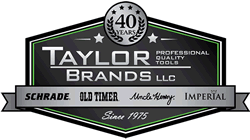 Founded by Stewart Taylor in 1975, Taylor Brands has been manufacturing, designing, and distributing high-quality stainless steel cutting tools and accessories since our inception. Taylor Brands owns and produces Schrade, Old Timer, Uncle Henry, and Imperial branded products, and are also licensed to produce multiple product lines under the world famous Smith & Wesson brand. In total Taylor Brands manufactures several hundred different products including fixed and folding knives, collapsible batons, tactical pens, handcuffs, tactical and survival accessories, and flashlights.
Founded by Stewart Taylor in 1975, Taylor Brands has been manufacturing, designing, and distributing high-quality stainless steel cutting tools and accessories since our inception. Taylor Brands owns and produces Schrade, Old Timer, Uncle Henry, and Imperial branded products, and are also licensed to produce multiple product lines under the world famous Smith & Wesson brand. In total Taylor Brands manufactures several hundred different products including fixed and folding knives, collapsible batons, tactical pens, handcuffs, tactical and survival accessories, and flashlights.
--